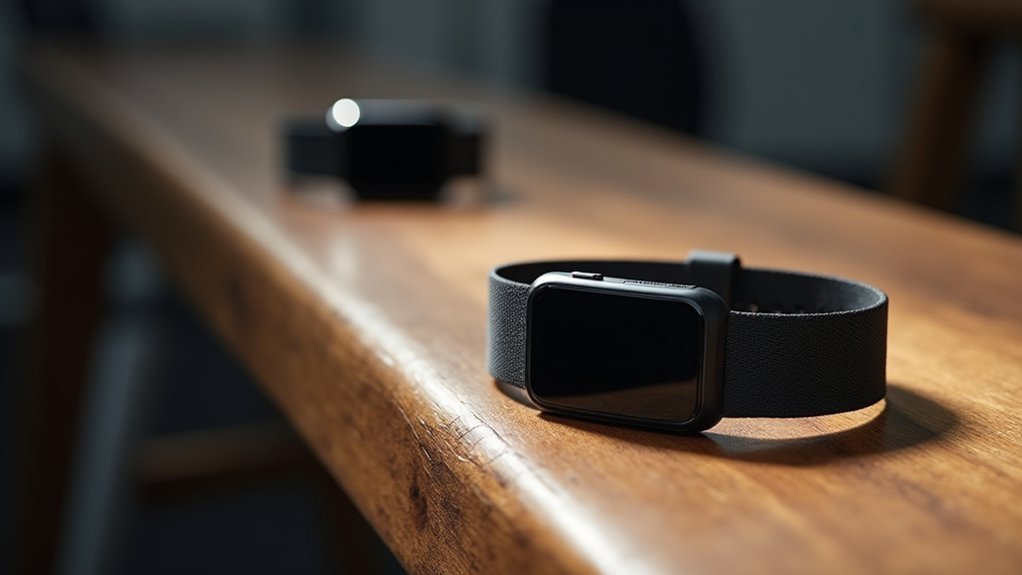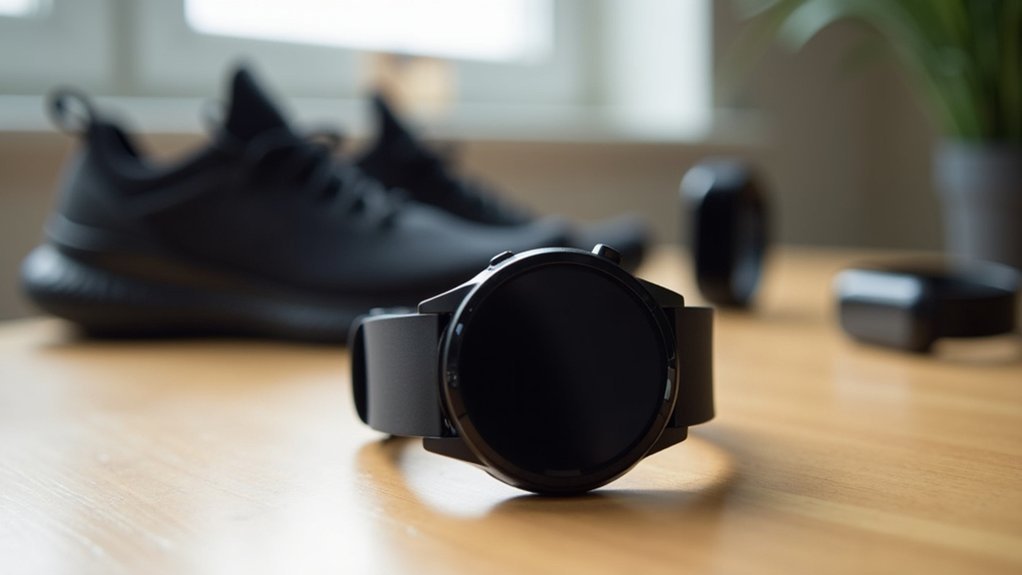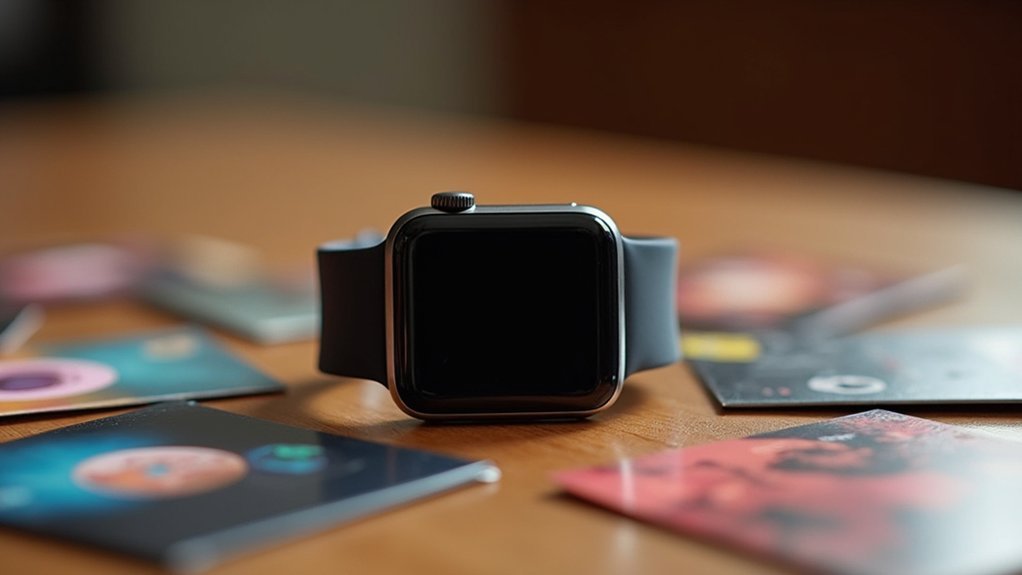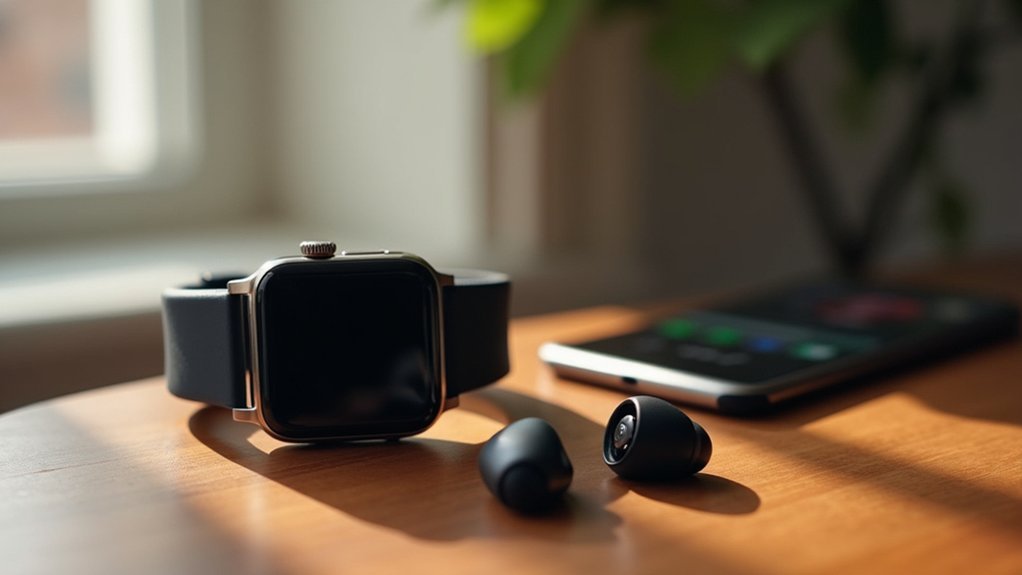For heart rate recovery tracking, chest straps like the Polar H10 offer the highest accuracy (99.6%) compared to wrist-based devices. Garmin Forerunner 255 automatically calculates HRR post-exercise, while Apple Watch provides detailed recovery metrics through apps like Heart Analyzer. Fitbit Charge 6 delivers real-time recovery data with improved accuracy. Your choice depends on whether you prioritize precision (chest straps) or convenience (smartwatches). The following breakdown explores each option’s unique recovery features.
Understanding Heart Rate Recovery and Why It Matters

The steady drop in your pulse after exercising reveals essential information about your cardiovascular health.
Heart Rate Recovery (HRR) measures how quickly your heart rate returns to resting levels one minute after peak exercise. A faster recovery indicates better fitness and autonomic nervous system function.
Why should you care? HRR serves as a powerful predictor of cardiovascular risk and mortality. Your recovery rate reflects both parasympathetic and sympathetic nervous system health, providing insights beyond what standard fitness metrics offer.
Multiple factors affect your HRR, including age, fitness level, genetics, and environmental conditions. Research shows that elite athletes typically have faster recovery rates, with an average HRR of approximately 29 beats per minute.
Monitoring this metric helps you assess exercise effectiveness, optimize training intensity, and track improvements in your cardiovascular fitness over time.
It’s not just about how hard you can push—it’s how efficiently you recover.
Key Metrics to Monitor for Optimal Recovery
Your daily HRV fluctuations offer essential insights into your recovery status, with declining trends often signaling overtraining or insufficient rest.
The quality of your sleep directly impacts HRV readings, making overnight measurements particularly valuable for evaluating recovery readiness.
You’ll notice stronger recovery patterns when tracking both metrics together, as improved sleep typically correlates with higher HRV and enhanced recovery capacity. Dedicated devices like the Oura ring and Whoop band provide more specialized data than general smartwatches for tracking these recovery metrics.
HRV Day-to-Day Analysis
Monitoring heart rate variability (HRV) on a daily basis provides critical insights into your body’s recovery status and overall health. Several devices excel at tracking these metrics, with the Polar H10 offering exceptional accuracy for serious athletes, while the WHOOP Strap 4.0 provides thorough recovery analysis.
For everyday monitoring, the Apple Watch and Oura Ring deliver reliable HRV data through different form factors. The Apple Watch uses both ECG and PPG technology, while the Oura Ring excels at sleep-based recovery monitoring. Higher HRV scores generally suggest improved vagal tone and better autonomic regulation.
When analyzing your data, remember that high HRV typically indicates better recovery, while consistently low readings suggest inadequate rest. Track your personal baseline over time rather than comparing to others, as HRV is highly individualized and most valuable when viewed as a trend.
Sleep-Recovery Connection
Sleep represents the cornerstone of effective recovery, with several key metrics revealing how well your body repairs and rebuilds during rest. Your body’s recovery processes primarily occur during deep sleep phases, making both sleep quality and duration critical factors. WHOOP data shows that members average 7:11 hours of actual sleep each night, highlighting the importance of tracking both time in bed versus true sleep time.
| Metric | What It Indicates | Ideal Range |
|---|---|---|
| HRV | Autonomic nervous system balance | Higher than personal baseline |
| Deep Sleep % | Physical recovery quality | 15-25% of total sleep |
| Sleep Duration | Overall recovery potential | 7-9 hours for adults |
| Resting Heart Rate | Recovery status | 5-10 BPM below awake average |
| Respiratory Rate | Stress and recovery state | 12-20 breaths per minute |
Monitoring these metrics with devices like WHOOP or Eight Sleep allows you to make informed decisions about training intensity and recovery needs, helping you enhance performance while minimizing injury risk.
Top Garmin Watches for Heart Rate Recovery Tracking
When selecting a Garmin watch for heart rate recovery tracking, you’ll find several models offering varying levels of functionality and automation.
The Forerunner 255 Series provides detailed tracking, automatically calculating the difference between your exercise heart rate and recovery rate after two minutes.
For maximum precision in recovery metrics, the Forerunner 255 Series automatically calculates your two-minute heart rate recovery differential without user intervention.
The Forerunner 230/235 supports this feature but might require manual calculation.
If you choose the Instinct Solar, you’ll need to select the recovery feature after your workout and remain still during the two-minute measurement period.
While wrist-based monitoring is convenient, it’s slightly less accurate than chest straps.
Note that recovery heart rate isn’t calculated for low-impact activities like yoga.
For thorough tracking, consider the Fenix or Venu series, though specific recovery features vary by model.
To get the most accurate recovery data, mark the end of your exercise with the Lap button and allow your watch to continue recording for an additional two minutes post-exercise.
Fitbit’s Advanced Recovery Monitoring Features
Fitbit has revolutionized recovery monitoring with its sophisticated suite of features designed to track how quickly your heart rate returns to normal after exercise.
The Charge 6 offers up to 60% more accurate heart rate tracking during intense workouts thanks to improved optical sensors and machine learning algorithms borrowed from the Pixel Watch.
You’ll benefit from continuous monitoring that provides real-time heart rate recovery data through the user-friendly Fitbit app.
The Daily Readiness Score combines your HRV, sleep quality, and activity levels to help you prioritize recovery effectively.
With customizable alerts for high and low heart rates, you’ll stay informed about your cardiovascular health throughout the day.
However, users should know that Fitbit requires manual tracking methods for recovery heart rate since it’s not automatically monitored by the device.
Fitbit’s ECG app further enhances recovery insights by detecting potential atrial fibrillation, giving you a thorough picture of your heart’s performance.
How Chest Straps Like Polar H10 Provide Superior Accuracy

When you wear chest straps like the Polar H10, the direct electrode contact with your skin captures electrical signals from your heart with 99.6% accuracy compared to ECG measurements.
You’ll notice these devices maintain their precision even during intense workouts because they’re positioned closer to your heart, minimizing motion artifacts that plague wristband monitors.
The immediate data transmission helps you track your heart rate recovery in real-time, allowing for on-the-spot training adjustments based on your body’s actual response. For serious athletes, these monitors can be paired with multiple devices simultaneously through dual connectivity options to record comprehensive performance data.
Electrode Contact Matters
Because they detect electrical activity directly from your heart, chest straps like the Polar H10 deliver notably more accurate heart rate measurements than wrist-based alternatives. This superior accuracy stems primarily from electrode contact quality.
For ideal results, make sure your chest strap fits snugly just below your sternum. The electrodes should maintain consistent contact with your skin throughout your workout. If you’re struggling with erratic readings, try moistening the electrodes—this simple step greatly improves signal quality, especially if you have a smaller frame. These chest strap monitors achieve 99.6% accuracy when worn correctly against the skin.
Studies confirm chest straps’ reliability, with devices like the Polar H7 showing 0.98 agreement with medical-grade ECG equipment—far outperforming optical sensors found in smartwatches and armbands.
This precision is critical when tracking heart rate recovery, where even small measurement errors can mislead your training assessments.
Real-Time Data Transmission
Unlike optical sensors that periodically sample your pulse, chest straps like the Polar H10 continuously detect and transmit electrical signals directly from your heart with remarkable precision.
This real-time data transmission achieves up to 99.6% agreement with clinical ECG standards, even during intense exercise.
The Polar H10’s firm buckle and non-slip silicone spots maintain consistent skin contact, preventing motion artifacts that plague wrist-worn devices. It’s recommended to moisten the sensors before use to ensure accurate readings from the start of your workout.
This stability guarantees uninterrupted data streaming vital for accurate Heart Rate Recovery measurement.
With dual Bluetooth and ANT+ connectivity, you can simultaneously pair with multiple devices while enjoying a strong transmission range.
This beat-to-beat precision captures the steep post-exercise heart rate decline without the smoothing errors common in optical sensors, delivering reliable HRR metrics that truly reflect your cardiovascular fitness.
Samsung Galaxy Watch 7: Recovery Features Worth Noting
The Samsung Galaxy Watch 7 offers a thorough suite of recovery monitoring capabilities through its advanced BioActive sensor technology.
You’ll benefit from continuous heart rate tracking with alerts for abnormal readings and irregular rhythms, including AFib detection and ECG functionality.
Recovery assessment is extensive, combining sleep metrics into a Sleep Score that reflects your physical and mental restoration.
The watch tracks sleep stages, blood oxygen levels, respiratory rate, and even detects sleep apnea (with a Galaxy phone).
While not explicitly marketing heart rate variability, the watch enables post-workout heart rate analysis and trend monitoring over time. For best results, you should remain completely still while taking these measurements to ensure the highest accuracy.
Combined with stress measurements, skin temperature tracking, and body composition analysis, you’ll gain valuable insights into your recovery status and overall fitness progression.
Comparing Battery Life for Continuous Recovery Monitoring
Your device’s battery capacity directly impacts how consistently you’ll track your heart rate recovery, with options like Polar H10’s 30-hour monitoring contrasting sharply with quick-charge alternatives.
When choosing between extended-use devices and those requiring frequent charging, you’ll need to balance convenience against the continuity of data collection for ideal recovery insights. The MyZone MZ-Switch offers versatility with its dual sensor system that adapts to different wearing positions while maintaining reliable battery performance.
Battery decline can also affect sensor accuracy in some wearables, potentially compromising your recovery metrics as power levels drop below certain thresholds.
Extended vs. Quick-Charge Devices
When selecting a heart rate recovery monitor, battery life often determines how effectively you’ll track your health over time. Extended-charge devices like the Withings ScanWatch 2 offer up to 30 days of use, enabling uninterrupted monitoring of recovery patterns and trends.
While Garmin Venu 3 and Fitbit Sense 2 also provide impressive battery longevity, quick-charge options like the Fitbit Inspire 3 and Amazfit Active 2 require more frequent charging but typically cost less. Users should be prepared for a short waiting time while devices verify and process heart rate recovery data for accuracy.
The Garmin Forerunner series balances this with rapid charging capabilities.
Your choice ultimately depends on priorities: extended devices guarantee continuous data collection without interruption, improving accuracy and compliance, while quick-charge options offer affordability and convenience.
Consider how the device’s battery life aligns with your recovery monitoring needs and lifestyle.
Accuracy During Battery Decline
As batteries deplete in heart rate recovery monitors, the accuracy of sensor readings can greatly decline, creating potential gaps in your health data.
Devices with effective power management systems, like the Garmin Forerunner 265, maintain consistent sensor performance even as battery levels drop.
You’ll find the Withings ScanWatch 2’s impressive 30-day battery life particularly valuable for uninterrupted monitoring. Its robust power management minimizes accuracy fluctuations during extended use.
Similarly, the Fitbit Sense 2’s advanced sensors continue to deliver reliable readings even when power is diminishing.
Look for devices that validate data during low battery states and provide timely low-power alerts to prevent data loss.
Those with significant onboard storage will retain your recovery metrics even when battery performance is compromised, ensuring continuous tracking of your heart health.
Sleep Quality Tracking and Its Impact on Heart Recovery
Sleep quality fundamentally impacts cardiovascular recovery, creating a critical relationship that modern health tracking devices can now measure. When you’re sleep-deprived, your heart rate remains elevated and HRV decreases, hampering recovery even after physical exertion. Recent research among medical students from Brazil revealed that poor sleep quality is significantly correlated with reduced heart rate variability.
| Sleep Metric | Heart Recovery Impact | Tracking Technology |
|---|---|---|
| Sleep Duration | Longer sleep supports ideal autonomic balance | Wearable devices with accelerometers |
| Sleep Efficiency | Higher efficiency maintains cardiovascular health | Sleep stage analysis algorithms |
| Sleep Consistency | Regular patterns enhance recovery metrics | Non-invasive HRV monitoring |
Today’s wearables don’t just count steps—they analyze sleep stages and monitor how your heart recovers overnight. By tracking these metrics consistently, you’ll gain insights into your cardiovascular recovery patterns and can make adjustments to improve both sleep quality and heart health.
App Ecosystems: Which Provide the Best Recovery Insights
Which app ecosystem truly delivers the most valuable heart rate recovery insights? Apple Watch leads the pack with apps like Heart Analyzer providing detailed recovery metrics and seamless ECG integration.
Apple’s ecosystem dominates recovery analytics with unmatched depth and seamless integration for serious health monitoring.
You’ll benefit from thorough data visualization and HRV analysis that outpaces competitors. Many smartphone-based options use photoplethysmography technology to detect blood volume changes in capillaries during heartbeats.
Wear OS and Google Fit offer decent alternatives but lack the depth of recovery-specific insights found in Apple’s ecosystem. While smartphone apps using photoplethysmography provide convenience, their accuracy falls short compared to dedicated devices—especially during varying exercise intensities.
For best results, choose platforms offering customizable heart rate zones, robust data export capabilities, and integration with wearable devices.
Apple Health and Google Fit integration guarantees your recovery data synchronizes across platforms, making long-term tracking more consistent and meaningful for monitoring your cardiovascular health.
Customizing Your Device for Personal Recovery Goals
Personalizing your heart rate recovery device releases its full potential for your specific health and fitness journey. Input your age, weight, height, and fitness level to improve accuracy, then set custom heart rate zones that align with your recovery targets. Remember that many users emphasize the importance of listening to your body over relying solely on device metrics.
| Device Feature | Personalization Options |
|---|---|
| Recovery Goals | Set rest day priorities and training load balance |
| Alert Systems | Customize notifications for HR zone violations |
| Data Display | Choose which metrics appear on your dashboard |
Advanced devices like Whoop and Oura use adaptive algorithms that learn from your patterns over time. After significant fitness improvements or health changes, use calibration features to reset your baseline. For specialized recovery tracking, adjust sensor sensitivity settings and sampling rates to match your specific needs.
Real-World Performance: Athlete Experiences With Recovery Devices
Evidence from elite competitors reveals how heart rate recovery devices perform under the demanding conditions of real-world training.
Combat athletes particularly value WHOOP 4.0’s ability to manage the stresses of intense training and sparring through 24/7 recovery monitoring.
Garmin Forerunner 965 earns praise for its detailed heart rate zones and VO2 Max metrics, helping athletes optimize their conditioning.
The watch’s advanced features like lactate threshold and heat acclimation tracking provide thorough performance insights.
Meanwhile, Polar Vantage V2 users appreciate how it helps them avoid overtraining through recovery insights based on training load analysis. The device’s FuelWise reminders ensure proper nutrition timing during extended training sessions.
For those seeking practicality, Garmin Instinct offers functional tracking with impressive battery life.
Athletes consistently rank Polar H10 as the gold standard for heart rate accuracy, making it a trustworthy companion for precise recovery data.
Emerging Technologies in Heart Rate Recovery Monitoring
While athletes benefit from established recovery tools in their training regimens, the landscape of heart rate recovery monitoring continues to evolve with groundbreaking technologies.
Smart clothing with integrated ECG sensors and advanced smartwatches like the Apple Watch Series 10 now offer continuous monitoring capabilities previously unavailable outside clinical settings.
Machine learning algorithms have dramatically improved risk classification accuracy, with recent studies showing 86% accuracy in identifying cardiovascular risks using a threshold of 28 beats per minute recovery.
University of Illinois researchers demonstrated that smart shirts equipped with electrocardiogram sensors can effectively track heart rate recovery after exercise.
These technologies can detect autonomic nervous system dysfunction and predict risk for sudden cardiac death and metabolic disorders.
You’ll soon see these devices integrated with healthcare systems, making preventive cardiology more accessible.
As algorithms improve and devices become more seamlessly incorporated into daily life, your ability to monitor heart health will continue advancing.
Frequently Asked Questions
Can Heart Rate Recovery Devices Detect Serious Cardiac Conditions?
Yes, some heart rate recovery devices can detect serious cardiac conditions. You’ll find ECG-capable devices like Fitbit Sense 2 and Withings ScanWatch 2 that can identify AFib and irregular heart rhythms through continuous monitoring.
Are Waterproof Recovery Trackers Accurate During Swimming Workouts?
Waterproof trackers struggle with accuracy during swimming. Your optical sensors face 10-25% error rates due to water refraction. For more reliable swimming heart rate data, you’ll want to use ECG chest straps instead of wrist-based devices.
How Do Extreme Temperatures Affect Heart Rate Monitor Accuracy?
Extreme temperatures greatly impact your heart rate monitor’s accuracy. Heat causes sweat interference and sensor slip, while cold reduces blood flow to your skin. Chest straps maintain better accuracy than wrist-worn optical sensors in both conditions.
Can Recovery Devices Help Manage Overtraining Syndrome Effectively?
Yes, recovery devices can effectively help you manage overtraining syndrome by tracking HRV, resting heart rate, and stress levels. They’ll alert you to early warning signs and provide customized rest recommendations when needed.
Are Prescription Medications Tracked for Their Impact on Recovery Metrics?
Currently, most fitness trackers don’t automatically track how medications affect your recovery metrics. You’ll need to manually correlate medication changes with your recovery data, though some new AI platforms are beginning to explore this integration.
In Summary
You’ll get the most accurate heart rate recovery data from chest straps like the Polar H10, though Garmin and Fitbit watches offer excellent convenience with extensive recovery metrics. Choose based on your needs—precision vs. wearability. Remember to customize settings for your fitness level, and check the companion app’s analysis capabilities. Your recovery tracking is only as valuable as the insights you can act upon.





Leave a Reply